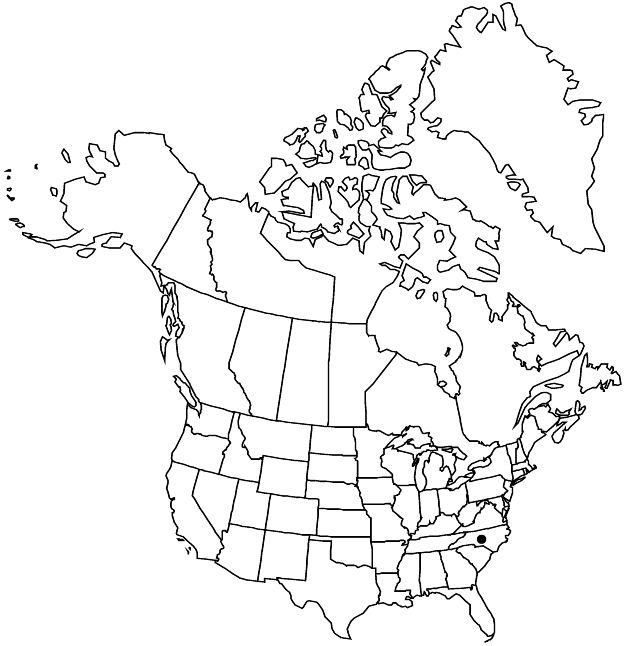Difference between revisions of "Crataegus roribacca"
J. Elisha Mitchell Sci. Soc. 17: 4. 1900.
FNA>Volume Importer |
imported>Volume Importer |
||
| (6 intermediate revisions by 2 users not shown) | |||
| Line 31: | Line 31: | ||
|distribution=N.C. | |distribution=N.C. | ||
|discussion=<p>Of conservation concern.</p><!-- | |discussion=<p>Of conservation concern.</p><!-- | ||
| − | --><p>Crataegus roribacca was found by Ashe in Swain County; no recent collection is known. The specimen studied (CM 289601) is in excellent condition and has all the hallmarks of ser. Tenuifoliae, although E. J. Palmer (1925) left it unassigned. The leaf differs from those of other members of the series in shape and size of marginal teeth, and from most in vein number. Crataegus roribacca does not seem to be a hybrid, so it is perhaps only an unusual form of C. schuettei.</p> | + | --><p><i>Crataegus roribacca</i> was found by Ashe in Swain County; no recent collection is known. The specimen studied (CM 289601) is in excellent condition and has all the hallmarks of ser. Tenuifoliae, although E. J. Palmer (1925) left it unassigned. The leaf differs from those of other members of the series in shape and size of marginal teeth, and from most in vein number. <i>Crataegus roribacca</i> does not seem to be a hybrid, so it is perhaps only an unusual form of <i>C. schuettei</i>.</p> |
|tables= | |tables= | ||
|references= | |references= | ||
| Line 40: | Line 40: | ||
-->{{#Taxon: | -->{{#Taxon: | ||
name=Crataegus roribacca | name=Crataegus roribacca | ||
| − | |||
|authority=Ashe | |authority=Ashe | ||
|rank=species | |rank=species | ||
| Line 55: | Line 54: | ||
|publication year=1900 | |publication year=1900 | ||
|special status=Conservation concern;Endemic | |special status=Conservation concern;Endemic | ||
| − | |source xml=https:// | + | |source xml=https://bitbucket.org/aafc-mbb/fna-data-curation/src/2e0870ddd59836b60bcf96646a41e87ea5a5943a/coarse_grained_fna_xml/V9/V9_962.xml |
|subfamily=Rosaceae subfam. Amygdaloideae | |subfamily=Rosaceae subfam. Amygdaloideae | ||
|tribe=Rosaceae tribe Gillenieae | |tribe=Rosaceae tribe Gillenieae | ||
Latest revision as of 23:00, 5 November 2020
Trees, 40–70 dm. Stems: trunk bark dark gray, thin, scaly; twigs: new growth not recorded, 1-year old mid brown, ± glossy, older dark gray; thorns on twigs few, 1-year old color not recorded, 3–5 cm. Leaves: petiole length 50–60% blade, glandularity not recorded; blade ovate to broadly elliptic (suborbiculate or broadly deltate on extension shoots), 4–5.5 cm (larger on extension shoots), base broadly cuneate to truncate (truncate to cordate on extension shoots), lobes 0, or 3 or 4 per side, sinuses shallow, lobes often mere apiculi, margins serrate, teeth 1.5–3 mm, veins 6 or 7 per side, apex acuminate, adaxial surface densely crisp-pubescent young, glabrescent. Inflorescences 8–20-flowered; branches glabrous; bracteoles few, linear. Flowers 13–15 mm diam., hypanthium glabrous; sepal length not recorded, margins entire, abaxially glabrous; stamens 20, anthers purple; styles 3. Pomes dark red, sometimes with orange or orange-red spots, broadly pyriform, 14–17 mm diam., smooth; flesh pale yellow; sepals recurved; pyrenes 3, dorsally deeply grooved.
Phenology: Flowering Apr; fruiting Sep.
Habitat: Habitat not recorded
Elevation: 600–700 m
Discussion
Of conservation concern.
Crataegus roribacca was found by Ashe in Swain County; no recent collection is known. The specimen studied (CM 289601) is in excellent condition and has all the hallmarks of ser. Tenuifoliae, although E. J. Palmer (1925) left it unassigned. The leaf differs from those of other members of the series in shape and size of marginal teeth, and from most in vein number. Crataegus roribacca does not seem to be a hybrid, so it is perhaps only an unusual form of C. schuettei.
Selected References
None.
